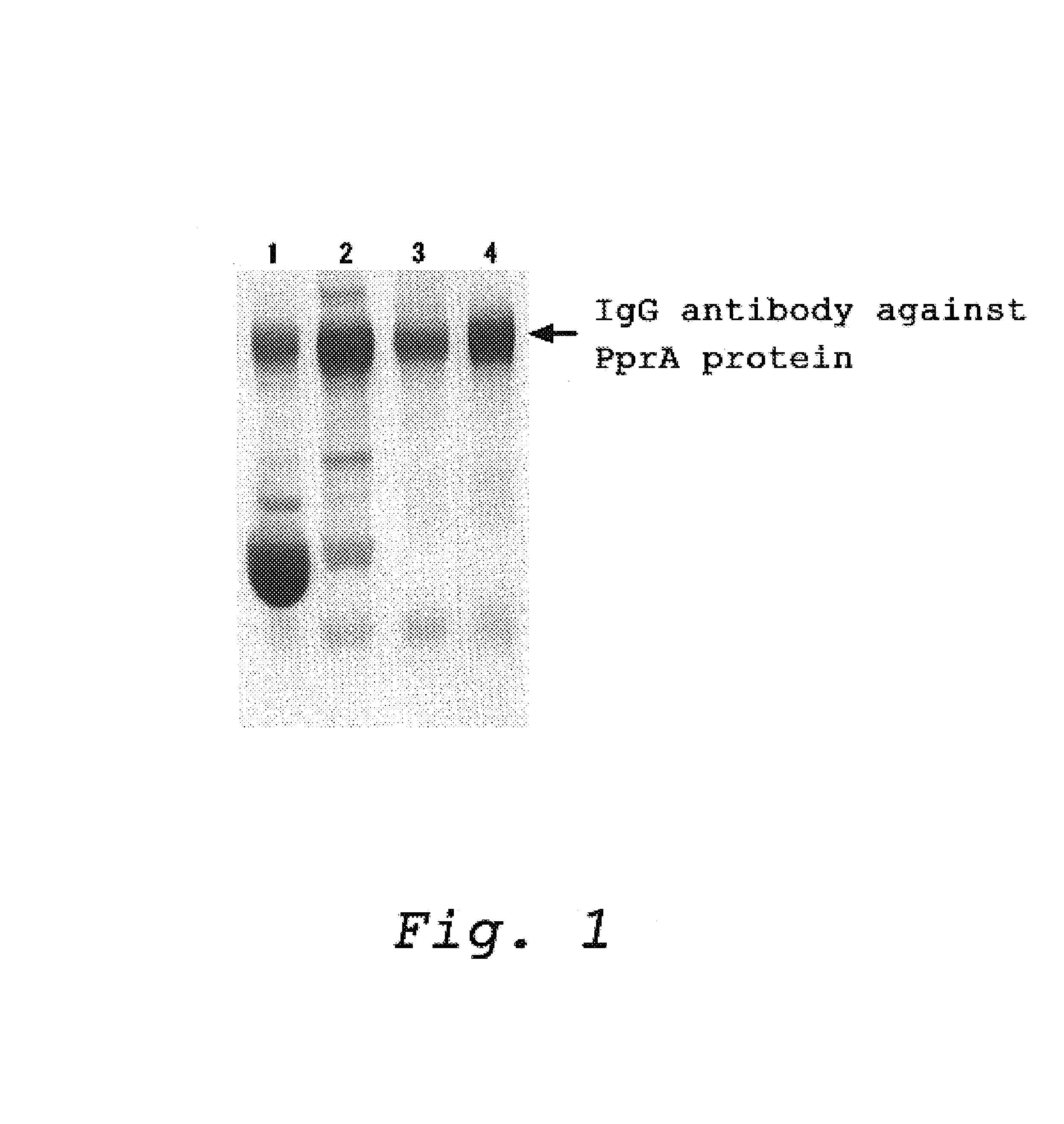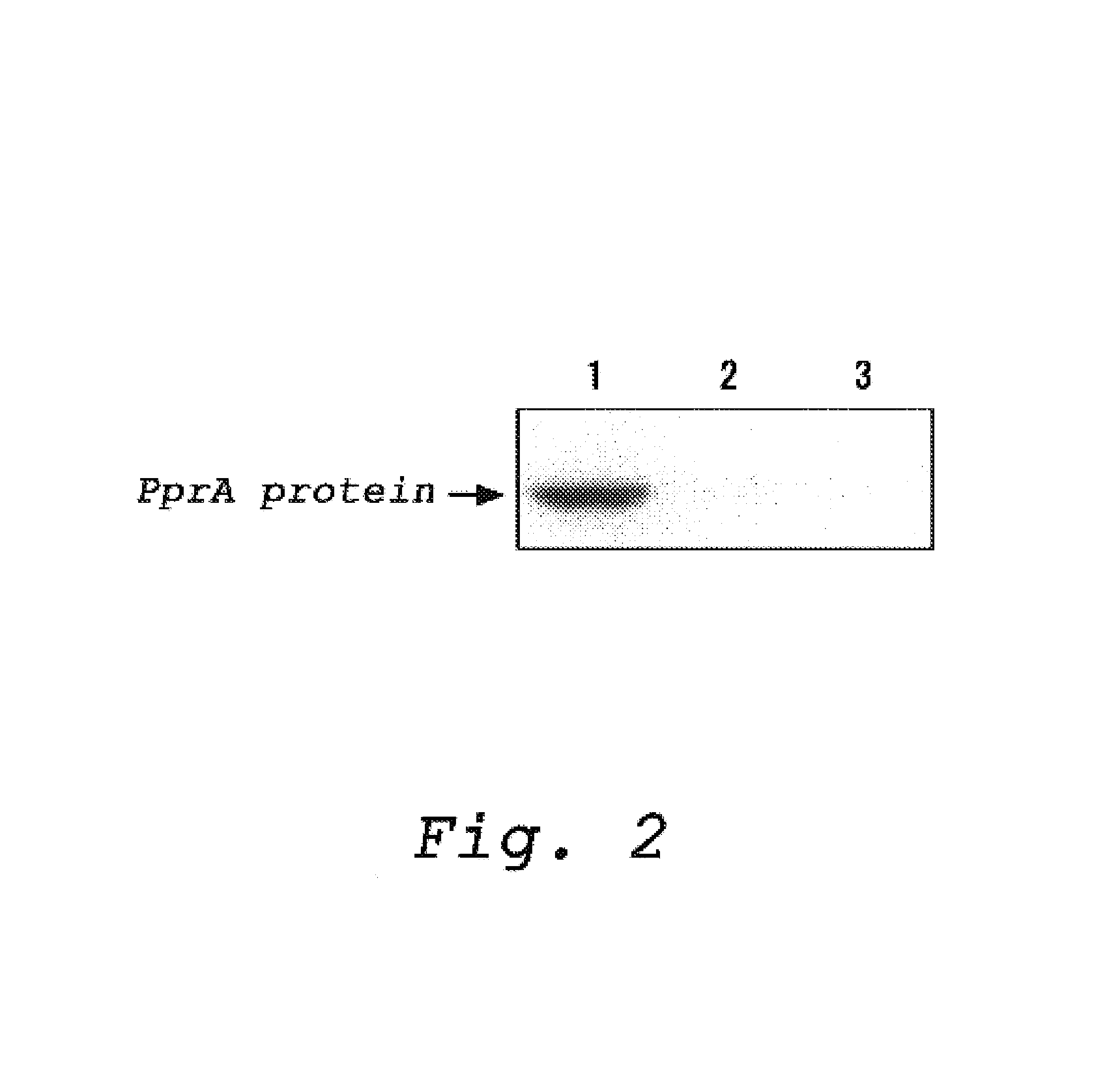Method for efficiently determining a DNA strand break
a dna strand and efficient technology, applied in the field of dna strand break efficiently determination, can solve the problems of aging, cell death, tumorigenesis or carcinogenesis, dna strand break is a particularly serious form of dna damage, and has a particularly deleterious effect on cells, so as to achieve specific binding activity, specifically and sensitively detect dna strand break(s)
- Summary
- Abstract
- Description
- Claims
- Application Information
AI Technical Summary
Benefits of technology
Problems solved by technology
Method used
Image
Examples
example 1
Production of a Polyclonal Antibody which Recognize a Protein Having an Ability to Recognize and Bind to DNA Strand Break (PprA)
[0034](1) Preparation of the PprA Protein
[0035]The protein, PprA, was prepared according to the method described in Japanese Patent Public Diclosure No. 2003-052376 (JP-A-052376 / 2003, corresponding to Japanese patent application No. 246260 / 2001). More specifically, the protein, PprA, was prepared by the method below:
[0036]PCR was carried out using a full-length pprA gene encoding the PprA protein which was contained in a plasmid as a template and primers (primer 1: 5′-gggcataata aaggccatat ggcaagggct aaagc-3′ (SEQ ID NO: 3) and primer 2: 5′-ttttggatcc tcagctctcg cgcaggccgt gc-3′ (SEQ ID NO: 4)) to amplify the gene pprA having 855 bp of an open reading frame (SEQ ID NO: 2). The pprA gene was integrated into E. coli expression vector pET3a (Novagen) to prepare an expression vector called pET3pprAwt.
[0037]Then, the pET3pprAwt plasmid as prepared above was used...
example 2
A Method for Detecting a DNA Strand Break In a Mammalian Cell Nucleus Using a Protein Having an Activity to Recognize and Bind to a DNA Strand Break and an Antibody which Specifically Binds Thereto
[0045]An example is shown here in which a DNA strand break induced by gamma ray irradiation within a nucleus of a fibroblast cell derived from Chinese hamster ovary (CHO-K1) could be detected using a protein having a DNA binding activity which was prepared in Example 1 and a fluorescent labeled polyclonal anti-PprA IgG antibody.
[0046](1) Preparation of Cells
[0047]CHO-K1 cells are cultured using Ham's F12 culture medium supplemented with 10% FCS in CO2 incubator (5% CO2) at 37° C. After removing the culture medium from a culture dish using an aspirator, the cells which were attached to the culture dish were washed twice using the bivalent ions free-phosphate buffered saline (PBS (−)). After washing, by adding PBS (−) containing 0.05% trypsin and 0.02% EDTA to the cells, and by stirring the ...
example 3
A Method for Detecting a DNA Strand Break in Mitochondria of Mammalian Cells Using a Protein Having an Ability to Recognize and Bind to a DNA Strand Break and an Antibody which Specifically Bind to the Protein
[0062]This example shows that a protein having an ability to recognize and bind to a DNA strand break as prepared in Example 1 and a fluorescence labeled IgG antibody are used to detect a DNA strand break generated by gamma ray irradiation in mitochondria DNA of CHO-K1 cells.
[0063]CHO-K1 cells which were adhered on a cover glass were prepared by the same method as Example 2-(1). MitoRed (excitation wavelength at 560 nm; Dojin kagaku), which can specifically stain mitochondria, was applied to the cells at a final concentration of 100 nM, which were incubated in CO2 incubator (5% CO2) for 60 minutes at 37° C. After incubation, the cells were irradiated with 0, 5, 10, and 20 Gy of gamma ray which were generated from 60Co as a radiation source using a similar method to that of Exam...
PUM
| Property | Measurement | Unit |
|---|---|---|
| Frequency | aaaaa | aaaaa |
Abstract
Description
Claims
Application Information
 Login to View More
Login to View More - R&D
- Intellectual Property
- Life Sciences
- Materials
- Tech Scout
- Unparalleled Data Quality
- Higher Quality Content
- 60% Fewer Hallucinations
Browse by: Latest US Patents, China's latest patents, Technical Efficacy Thesaurus, Application Domain, Technology Topic, Popular Technical Reports.
© 2025 PatSnap. All rights reserved.Legal|Privacy policy|Modern Slavery Act Transparency Statement|Sitemap|About US| Contact US: help@patsnap.com



